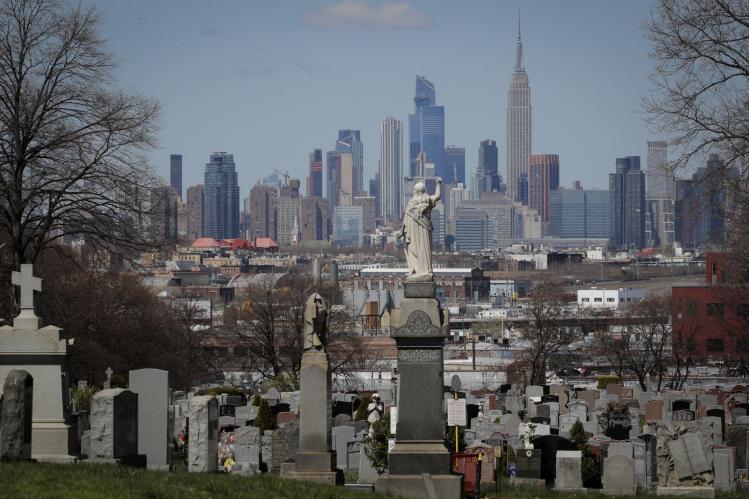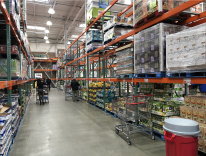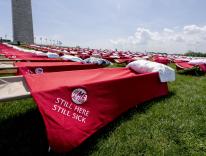
The first sign appeared on the door of the priests’ retirement residence where I live. It was March 10 and the sign read: “No Visitors Until Further Notice.” Of the approximately thirty residents, perhaps only six or seven get out with any frequency, helping in parishes and attending an occasional concert. But all follow the news closely and were aware of the increasing threat from the insidious virus that had made its way from China to Europe and was now reaching New York. So the posted sign, though unwelcome, did not come as a complete surprise.
A second sign was the decision to reduce the “density” at the evening meal. We changed from one sitting to two so that, instead of four men at a table, there would be only two—one across from the other. Though this meant extra work for the staff, they accommodated themselves to the new arrangement with generosity and kindness.
A third sign appeared on March 21, and this more foreboding. Our usual custom is to celebrate Mass together in the late morning, with those attending seated along the chapel’s walls, some in wheelchairs, others with walkers. Only the main celebrant would stand at the altar. It became apparent that we were physically much too close and that, even without an actual exchange of peace, our proximity could be a risk. And so the sign posted on the chapel door declared: “Mass Suspended.” Of course, some continue to celebrate Mass in their rooms, but others have joined the dolorous Eucharistic fast suffered by the immense majority of God’s people.
I have lived here since the residence opened about three and a half years ago. In that time close to twenty men have died of causes ranging from Alzheimer’s to cancer. Most have been older than myself, but a few younger. As I would sit in the chapel, the words of the “Benedictus” about those “who dwell in the shadow of death” took on new significance. They seemed not morbid but actual and pertinent. In a culture in which death denial is so prevalent, any reminder of death’s inevitability can be salutary. It can help one appreciate the present moment, its grace and possibilities. It can focus attention on what is truly important.
Then on Saturday, March 28, a yet more ominous sign appeared. An ambulance drove up to the entrance of our residence and two EMS workers in protective gear emerged and wheeled a gurney into the building. After a brief time they came out, bearing one of our retired priests. The following day a sad notice on the bulletin board reported his death. It was only the following Tuesday that the news came that he had tested positive for the virus.
Four men, who by then showed symptoms that caused concern, were taken either to the hospital or to a nursing facility. A new protocol was instituted for the remaining residents. All meals would be delivered to the rooms and left on a chair outside the door. Masks were to be worn during any necessary interaction. We were in effect quarantined within our rooms.
Since then two men who had been transferred from the residence have died. To my knowledge neither was tested, though one surmises that the virus was a contributing factor. Our experience here only reinforces the general impression that the number of deaths attributable to the virus far surpasses the officially announced total.
I am acutely aware that here in the residence we are both privileged and vulnerable. Privileged because of so many committed workers who provide for our needs—health-care providers, kitchen staff, maintenance people, food-delivery people, postal workers. Yet I am also aware of the vulnerability of elderly men, who often have other health problems. And though those who come to work here are checked for symptoms and take ordinary precautions, like simple masks, there is the real possibility that some of them are asymptotic bearers of the invisible enemy.
I am also aware of the many in New York and elsewhere whose challenges far surpass our own. Those on the frontlines whose dedicated exploits we see morning and evening on the news. Families confined in homes both small and large, with restless children and teenagers. The homeless…one can barely imagine the plight of the homeless.
And so a new realization impresses itself: our unity in the Body of Christ. Not as some stirring theological notion, but as an ever-present reality. Never has prayer been more somatic, more alert to our oneness in the Body of Christ. Strange to say: in a time of diminished sacramentality, an enhanced corporeality may be growing. We may be beginning to fathom the mysterious truth of Paul’s words: “I am completing in my own flesh what is lacking in the afflictions of Christ for the sake of his Body, the Church” (Colossians 1:24).
A good part of this enhanced corporeality is a closer attunement to the rhythms of bodily existence. I have always appreciated the Divine Office and its relation to the rhythms of nature. Lauds at sunrise, Vespers at sunset. But when I’m awake in the middle of the night, the Office of Readings joins me to relatives and friends in different time zones: Australia, Italy, the United States from east to west. Whatever time of day or night it is where they are, all pulse to the rhythms of divine grace and praise. “From the rising of the sun to its setting a sacrifice of praise is offered to the Lord.”
Although I’m a diocesan priest, both my temperament and daily routine have always been somewhat monastic. Regular patterns of prayer (the Benedictine Opus Dei), study, teaching, writing. These continue but with an even more deliberate pattern. Rhythm again. Prayer has pride of place, but reading (the monastic lectio) takes up a good part of the morning. When inspiration strikes, I may undertake a short article. Since I’m an early riser (and an Italian) I usually take an afternoon nap, which sets the stage for further study in the afternoon.
I’ve also picked up a new habit: before bed I watch a musical performance on DVD. I have always loved to listen to classical music and have a wide selection of CDs. But lately I have found that watching musicians play the music concentrates my attention. It allows me to experience the music more deeply, to resonate with the gestures and expressions of the musicians. Their joy communicates itself to the viewer. We are not alone. A friend recently alerted me to the fact that on Amazon Prime TV, if one searches “Abbado,” one has access to all the Beethoven symphonies conducted by the great maestro with the Berlin Philharmonic. One can follow the arc of Beethoven’s genius, culminating in his Ninth Symphony. And then begin again, discovering new riches with each listening.
I have spoken of “privilege.” One of the surpassing privileges of our residence is the land that surrounds it, crowned by an overview of the Hudson River and the Palisades. Just to be able to walk outdoors safely in this time of quarantine is a privilege. To be able to do so amid such beauty is sheer grace. Spontaneously, St. Francis’s Laudato si’ wells up.
Images assume ever greater importance in this time of confinement. Imageless prayer may be fine for disembodied angels, but for us mortals images are life-giving and sustaining. Atop the dome of the chapel that my window faces is a bronze statue of Christ, beckoning with outstretched arms. Every time I glance up from my desk I see Jesus inviting: “Come to me all who are burdened.” Wondrously, the statue is illuminated at night. So day and night Jesus stirs and soothes my heart.
But it need not be an imposing statue. A simple crucifix, a favorite icon of Our Lady, a small print of a patron saint can equally well remind and impress upon each of us: “None of us lives to himself, and none of us dies to himself. If we live, we live to the Lord, and if we die, we die to the Lord. So, then, whether we live or whether we die, we are the Lord’s. For to this end Christ died and lived again, that he might be Lord both of the dead and the living” (Romans 14:7–9). Easy enough to quote. Our challenge, more than ever, is to make these words our own.
Listen to Fr. Imbelli on COVID-19 on the Commonweal Podcast:
Please email comments to [email protected] and join the conversation on our Facebook page.
Previous Story
Already & Not Yet
Next Story
Reframing American History

